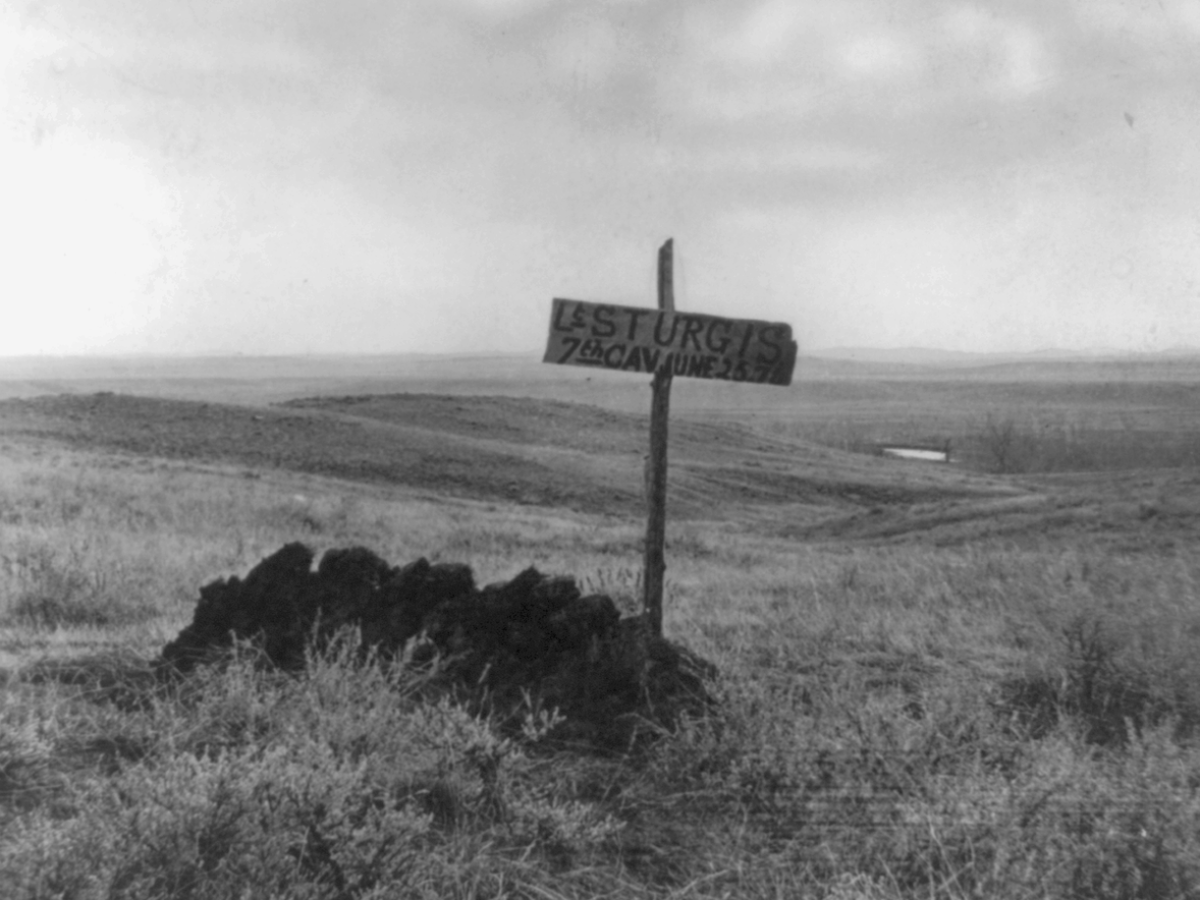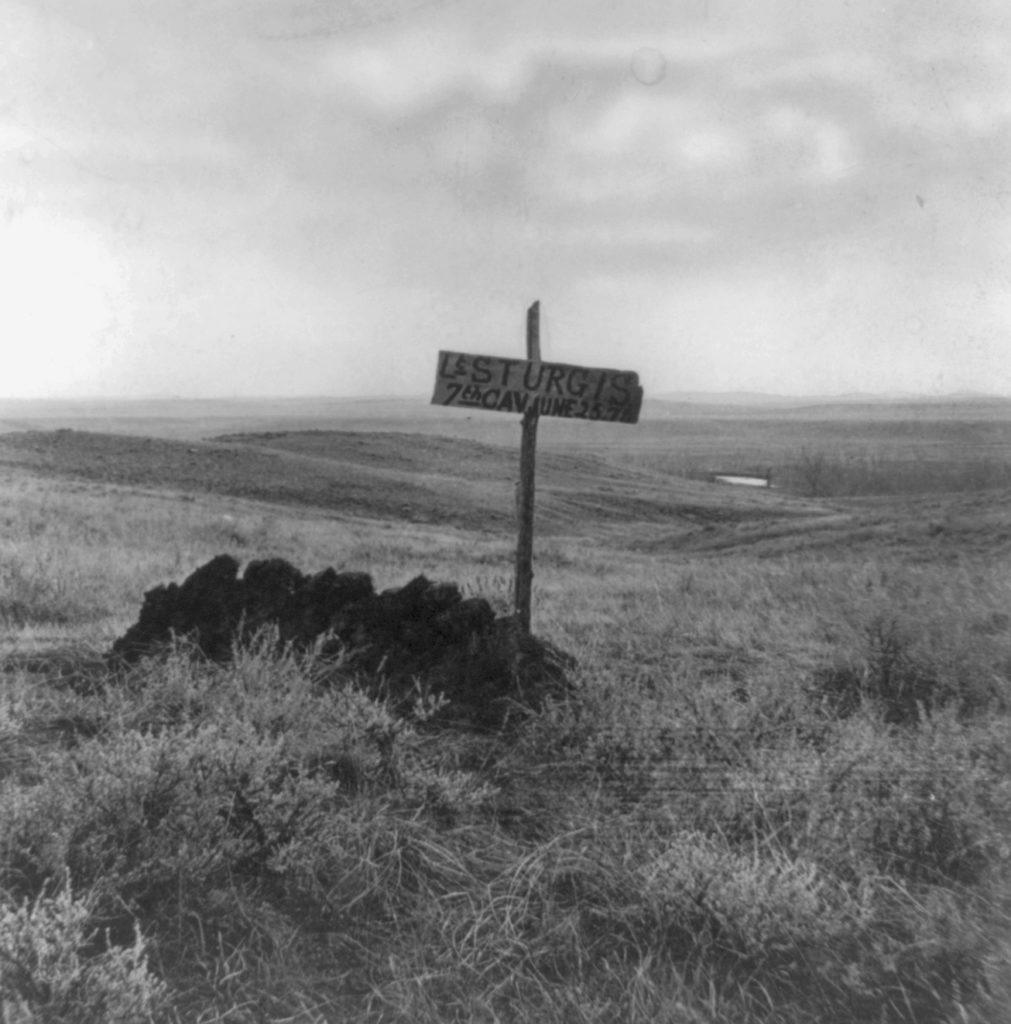Many a man in the Old West admitted owing his life to his horse. But Sergeant Daniel Kanipe of the 7th Cavalry owed his long life after the Battle of the Little Bighorn — as a husband, stepfather of two, father of eight, World War I militia captain and IRS agent — to somebody else’s horse.
“I was riding close to Sergeant [George A.] Finkle,” Kanipe wrote in the 1920s. “We were both close to Captain Tom Custer [George’s brother]. Finkle hollered at me that he couldn’t make it, his horse was giving out. I answered back: ‘Come on, Finkle, if you can.’ He dropped back a bit. Just then the captain told me to go back and find [Captain Thomas] McDougall and the pack train and deliver them orders that had just been issued by General [Lt. Col. George Armstrong] Custer…. I went back. I thought then that was tough luck, but it proved to be my salvation. If Sergeant Finkle had not dropped back a few minutes before, he would have got the orders — and I would not be telling this story.”
The orders were for McDougall to “bring the pack train straight across to high ground — if packs get loose don’t stop to fix them, cut them off. Come quick. Big Indian camp.” The last words Kanipe heard Custer shout, as he remembered it, had an ironic ring to them when he was writing in 1924: “Boys, hold your horses! There are plenty of them down there for all of us!”
As Kanipe turned back with the message, Finkle caught up with Company C on his weary horse. He forged ahead and was last officially seen by Privates Peter Thompson and James Watson, who had horse troubles of their own: Thompson’s played out and refused to budge; Watson’s collapsed and was unable to get back up. Watson started to kick his sprawled horse in desperation.
“I saw Sergeant Finkle of our company sitting calmly on his horse, looking on and making no effort to help Watson in his difficulty,” Thompson wrote in 1913. “But finally the poor animal gained his feet with a groan, and Finkle passed on with a rush to overtake our company.”
Kanipe took the message back to McDougall at the pack train, then caught up with Captain Frederick Benteen and took part in the defense of Reno Hill, atop which Benteen and McDougall consolidated seven companies and the civilian packers and fought off the Lakotas and Cheyennes through the rest of June 25 and 26. Thompson later showed up on Reno Hill, minus his horse, and Kanipe vouched for him: “He lost his horse by some means down there and came walking to the top of the hill.”
Recommended for you
The consensus of Kanipe and other Reno Hill survivors was that Thompson and Watson had actually had horse troubles but that Privates John Fitzgerald and John Brennan, who had also seen the size of the Indian camp, were simply terrified and held back when they could have followed the rest of Company C to the Little Bighorn with Finkle. Kanipe and Thompson each saw Finkle follow Custer. This substantiates the controversial survivor story of Frank Finkel, a Washington state farmer who was a forensic match for Finkle with remarkably similar handwriting.
Kanipe, however, threw the survivor story a curve: When he joined the Reno Hill soldiers who rode down to the Custer battlefield, he said that he saw Finkle “mutilated very badly” but found 1st Sgt. Edwin Bobo “not mutilated at all.” When Finkle’s best friend, Charles Windolph, went back to find Finkle’s body and give it a decent burial, he couldn’t find it. The memory of Windolph’s failure haunted him for decades afterward. And nobody else saw Finkle’s body or mentioned that Bobo’s body wasn’t mutilated. Since Kanipe later married Bobo’s widow and adopted Bobo’s two sons, the latter inconsistency may have been a simple gesture of chivalry or kindness.
Kanipe also said Custer had been shot only once — through the heart — while everyone else said twice, once in the heart and once in the head. He admitted in 1908 that he couldn’t identify his own captain, Tom Custer, who had been pounded to a pulp by vengeful Indians, and that most of the other corpses were so bloated and mutilated that identification was impossible. Yet in 1924, he claimed to have found Tom Custer immediately. Kanipe also reported finding 70 to 75 dead Plains Indians in three burial tepees, while other soldiers reported fewer than a dozen, and the Indians reported losing only 26 warriors and 10 to 20 women and children.
Little Bighorn researcher Walter Mason Camp found Kanipe a valuable observer and wrote in a 1910 letter to the sergeant, “There are none who remember as much as you do.” Kanipe’s memories of the battlefield, though, did not impress Custer scholar W.A. Graham, who wrote in 1924, “The many inaccuracies in Sergeant Kanipe’s story are characteristic of the accounts of most of the enlisted survivors recounted during the ’20s.”
But the influence that old age and nostalgic glory may have had in replacing the fear and horror of the actual event couldn’t take away Kanipe’s role in history: He was the last man in Company C and the next-to-last man (trumpeter John Martini was the last) to leave Custer’s five companies under orders and without suspicion of cowardice. He went on to build a successful life for himself and Bobo’s widow and orphans after Custer’s Last Stand.
Kanipe’s life before little bighorn
Daniel Alexander Kanipe, the son of Jacob Kanipe and the former Rebecca Isabella Mosteller, was born on April 15, 1853, in Marion, in the foothills of North Carolina’s Blue Ridge Mountains. Kanipe enlisted in the Army on August 7, 1872, and joined the 7th U.S. Cavalry at Yankton, Dakota Territory, in March 1873. At 5 foot 11, he was one of the tallest enlisted men in the 7th Cavalry — his buddy Finkle stood taller still, at 6 foot 1 inch — and Kanipe was a sturdy young man with dark blond hair and hazel eyes. He was proud of his blue uniform, and it showed when, following the custom of the cavalry, the best-dressed enlisted man was picked as orderly.
“You see, I was lucky in those days,” he recalled. “Seems like I would be made orderly nearly every guard mount. They said I was the neatest, and if there was anything to that, maybe I was.”
Kanipe took part in both the 1873 Yellowstone Expedition and the 1874 Black Hills Expedition, during which the presence of three Gatling guns and a 3-inch Rodman breechloading cannon may have kept the outraged Indians at a safe distance. Custer cut loose from the Gatling guns on June 22, 1876, three days before the Battle of the Little Bighorn took place — a mistake, Kanipe (who recalled two Rodmans as well as two Gatlings, another minor error) said in hindsight. Custer supporters explain that the wheeled weapons, hauled by condemned cavalry horses, might not have been able to keep up.
“There’s where he made a mistake, as we see it now,” said Kanipe, “because if he had had one of those Rodman guns and had fired it one time, those Indians wouldn’t have stopped running yet — no siree, would still be running. And if we’d had one of the Gatling guns, there would have been a lot more survivors than me. In fact, there would never have been any Custer massacre.”
Kanipe returned to Fort Abraham Lincoln with the survivors from Reno Hill — about half the regiment — and served out the last year of his five-year hitch. He also consoled, and ultimately married, Bobo’s widow, Missouri Ann Wycoff Bobo, also a native North Carolinian. Missouri Ann had married Bobo when she was only 15 and was widowed at 22, a year younger than Kanipe. After his discharge on August 7, 1887, Kanipe moved back to North Carolina with Missouri Ann and helped her raise Bobo’s two young sons, Frank and Charles. The couple later had three sons and five daughters of their own who lived to be adults.
GET HISTORY’S GREATEST TALES—RIGHT IN YOUR INBOX
Subscribe to our HistoryNet Now! newsletter for the best of the past, delivered every Monday and Thursday.
Kanipe took up farming and was active in the Presbyterian Church, and when active farming became arduous after he turned 50, he worked for the Internal Revenue Service for 20 years, possibly on the strength of a 1905 letter of recommendation from Thomas McDougall: “Sergeant Kanipe is an honest, sober, trustworthy man that always did his duty well, gaining the entire respect of the officers of his regiment, as also the enlisted men. I cannot too highly recommend him for any position of trust that may be given him, knowing that he will perform all duties well that are entrusted to him, with honesty, faithfulness, courage and loyalty to those who employ him… This soldier’s record is good all through, and I gladly recommend him for any position he may seek…. His hard service entitles him to great consideration.”
Kanipe served as treasurer of the MysticTie Lodge No. 237, a Masonic group. During World War I, already in his 60s, he was a captain in the North Carolina Home Guards. Daniel Kanipe died on July 18, 1926, at age 73. The old sergeant’s final memories may have been a little sketchy, but nobody who knew him doubted he had been a good soldier, a good husband and a good friend to have around in hard times.
Suzie Koster and Minjae Kim provided research. John Koster wrote “Custer Survivor.“
Originally published in the June 2012 issue of Wild West.








